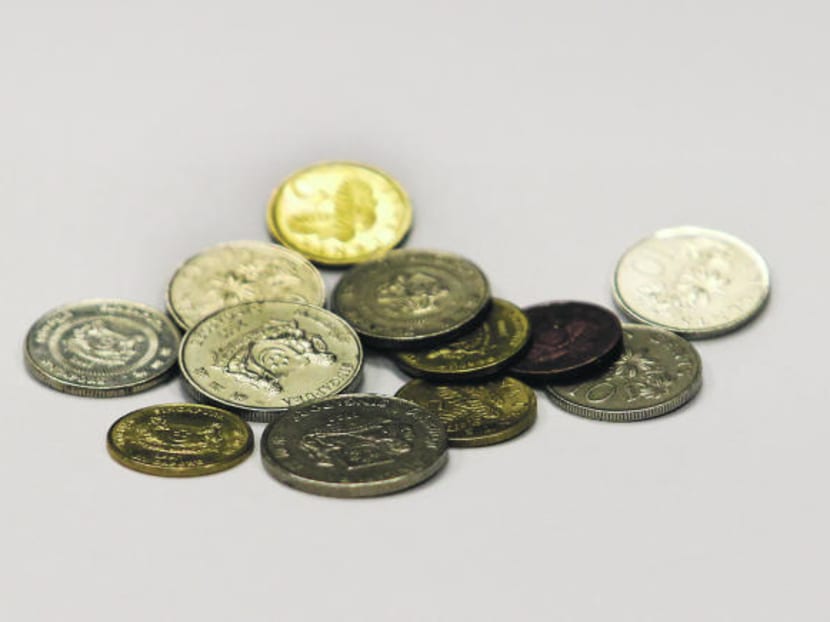MAS eyes limits for payments with coins
SINGAPORE — The number of coins — including the S$1 denomination — which a customer can use for payment in a single transaction could come under new limits proposed by the Monetary Authority of Singapore (MAS).
SINGAPORE — The number of coins — including the S$1 denomination — which a customer can use for payment in a single transaction could come under new limits proposed by the Monetary Authority of Singapore (MAS).
Following a review triggered by two highly-publicised cases of mischief in 2014 where large amounts of coins were used for payments, the MAS announced on Thursday (March 16) that it is proposing a uniform legal tender limit of 10 coins per denomination for each payment. This would apply to all denominations (5-cent, 10-cent, 50-cent and S$1). This translates to a maximum amount of S$18.50 which a consumer can pay fully in coins.
A public consultation exercise will be held until April 6. Under the Currency Act, the existing limit for denominations of 5-cent, 10-cent and 20-cent coins is S$2 per denomination.
The limit for 50-cent coins is S$10, while there is no cap on the number of S$1 coins that a customer can use in a single transaction.
In October 2014, a now-defunct electronics firm at Sim Lim Square gave a customer S$1,010 in coins after it was ordered to refund the amount by the Small Claims Tribunal. The shop’s owner Jover Chew was subsequently jailed and fined for cheating and insulting behaviour over a string of incidents involving various customers. In November 2014, a car dealer received S$19,067.85 in coins, which were contained in plastic bags dumped on the car showroom floor by a man who was ordered by the court to pay the company.
MAS said that following media reports of these cases, some members of the public “expressed the need to place a legal tender limit on one-dollar coins to prevent similar abuses”.
In coming up with the new limits, MAS said it was mindful they “should be kept simple, intuitive and easy to remember, while preventing acts of mischief and minimising inconvenience and cost in handling large quantities of low denomination currency”.
The central bank said it had surveyed a random sample of members of the public, as well as sought the views of various business associations. “The limit of 10 coins per denomination strikes a good balance between the interests of payers, who would want to be able to pay with as many coins as possible and payees, who would want a limit on the number of coins acceptable for payment to minimise inconvenience to them,” it said.
MAS stressed that if both sellers and customers agree on using quantities above the legal tender limit, they can go ahead and do so. Conversely, under the Currency Act, if a seller does not wish to accept certain denominations of currency notes or coins as payment or wishes to limit the quantity of coins used in a transaction, he must provide a written notice of this to his customers.
This is being practised in some coffeeshops or provison stalls, for example, where notices have been put up, stating the maximum number of 5-cent coins that would be accepted for each transaction.
Cash-heavy businesses as well as consumers TODAY interviewed were lukewarm about the proposed limits for larger denominations such as S$1 and 50-cent coins, although they would welcome a cap on the number of 5-cent coins per transaction.
Mr Hong Poh Hin, vice-chairman of the Foochow Coffee Restaurant and Bar Merchants Association, said that coffeeshops will be happiest about the new legal tender limit for 5-cent coins. “No one wants 5-cent coins. Customers will try to dump them on us, and if we try to give other customers their change in 5-cent coins, they don’t want it,” Mr Hong said. “So we are left with a lot of such coins, and banks will charge us a fee to change them into notes.”
He added: “However, if customers insist on giving us many 5-cent coins, we have no choice but to accept it. So this (proposal) is good, because we can tell them that legally, now we can accept a maximum of 10 5-cent coins.”
Nevertheless, Mr Hong noted that coffeeshops need a large number of high denomination coins, including 50-cent and S$1 coins.
Agreeing, Mr Douglas Ng, who owns a fishball noodles stall at Timbre+, said sometimes hawkers run out of coins. He said: “My usage of S$1 and 50-cent coins are quite high. I can use up to 100 or more such coins a day. Everyday, I go around to the other hawkers asking if I can exchange (notes) for their coins, as I don’t have enough.”
Corporate communications manager Ms Wendy Low, 33, pointed out that some shop owners “actually prefer to be paid in coins”. “And if I had that much excess coins, I would just get rid of them via a coin deposit machine, instead of using them as payment,” she said.







